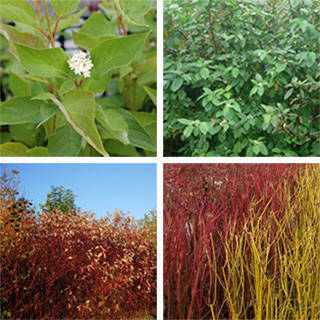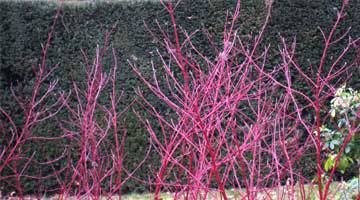
Dogwood Hedging Plants Guide
iOur Guide To Dogwood Hedge Plants
If you're looking for an eye-catching, intensely coloured garden hedge, we recommend investing in dogwood.
Often referred to by its scientific name Cornus, dogwood is a group of deciduous shrubs and trees that are recognised for their vividly coloured stems in orange and crimson tones. Dogwood blooms bountiful foliage in the summer and its vibrant branches are visible in winter, making this ornamental plant a year-round spectacle.
Dogwood received the RHS’s prestigious Award of Garden Merit for its dazzling appearance. In the wild it can be found growing along woodland edges and in hedgerows, but it is also often showcased in show gardens, designs, parks, watersides, and paths thanks to its ability to create a dazzling atmosphere. It's no wonder the dogwood hedge plant is a popular choice to have in the garden!
Dogwood Characteristics
Dogwood is suitable all year round and showcases various attributes that bring added interest to a garden throughout the seasons.
Foliage
During spring, Cornus boasts stunning clusters of flowers with flat heads of creamy white petals. These flowers later develop into black berries known as ‘dogberries’.
As the months move into autumn, the smooth, oval green leaves sit opposite one another along the stems and eventually turn a crisp, crimson colour.
Branches
As a deciduous plant, the rusted leaves will fall when the winter weather sets in, allowing the decorative bark to take centre stage. The branches are stripped of their leaves, allowing the dogwood structure to reveal its full beauty.
The attractive bark demonstrates an important value for gardeners. During the winter months, gardens can often look dull and uninviting thanks to the cold weather, bare beds, and colourless plants. This is why dogwood is a favourable hedge plant; it truly comes into its own in the coldest season and brightens up the garden until fresh foliage and flowers emerge in spring.
Wildlife
Dogwood also attracts an abundance of wildlife, such as bees and butterflies in spring and a variety of local birds who are unable to resist the autumn berries. The intricate stems and branches create a thick solid framework, which forms a sheltered nesting site for birds and a protected habitat for small animals.
Dogwood Planting
Planting a single variety of dogwood will produce a fantastic-looking feature. For a more exhilarating appearance, we recommend planting a combination of the coloured varieties to create a unique, contrasting hedge.
Dogwood plants also make a great addition to a native hedgerow, bringing added visual interest in the form of different shapes, textures, and colours. You can also plant this species in front of large, evergreen hedges as the taller backdrops contrast the eye-catching stem colours.
Soil
Dogwood is a resilient plant which will thrive in most normal soils and grows exceptionally well in rich, moist sites. The general rule of thumb for dogwood plants to achieve a more vibrant colour is to plant them in damp soil in positions that are fully exposed to the sun.
However, there's no need to be afraid of planting in the shade as it poses no threat to successful and healthy growth. Dogwood will thrive in covered areas, making it the perfect plant to bring life and colour to the darker parts of your garden.
When to plant
Bare-root dogwood shrubs are best planted between autumn and spring as they can establish their roots in the winter months.
The soil should be well prepared before planting. If the soil isn’t fertile or is overly dry, dig well-rotted organic matter or compost into the planting site. This will give dogwood nutrients to help it produce a strong show of colourful stems.
If you’re planting dogwood to enjoy its vivid hues in the winter, plant them 50-60 cm together to create a thick wall of colour.
Dogwood Pruning and Aftercare
Pruning is essential to get the best from your dogwood and gain the distinctive colours this plant is famous for. Brighter colours are emitted by new growth, therefore, strategic and severe pruning allows this plant to re-establish throughout the year, ready for winter. Dogwood is as tough as it looks and will thrive after a harsh cutback.
The ideal time to prune dogwood for a winter spectacle is in late March to mid-April, just before new buds appear. Remove almost a third of the stem; we suggest keeping the stems about 5-20 cm above ground level to produce more radiant bark in winter.
It’s a hardy plant so it can withstand a harsh prune and has a quick growth rate with an annual reach of 40-60 cm, so rest assured that it will grow back soon. In fact, the new growth should reward you with even bolder and brighter stems.
Colourful Alternatives to Dogwood
It’s clear that dogwood’s enchanting colours make it a prime choice for brightening up gardens. If dogwood isn't quite what you are looking for, we have a great selection of colourful alternatives, including a variety of evergreen and deciduous species.
For more information about dogwood, contact Hedges Direct's expert team today on 01257 494 159 or email us at [email protected].
Show more >>>
Show less <<<


-Stems-Close-Up.jpg)
-Leaf-Close-Up.jpg)
-Stems-Close-Up.jpg)
-Stems-Close-Up.jpg)











